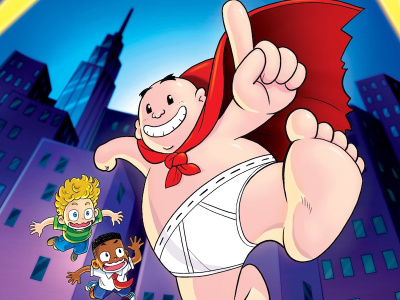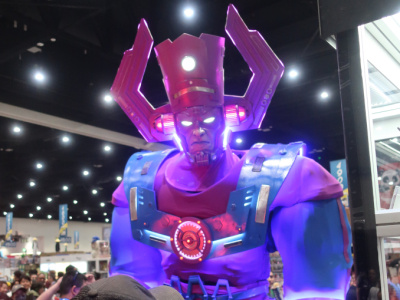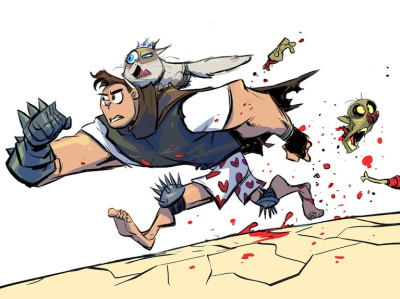
We recently spoke to Liza Coppola, Viz Media Vice President Sales and Marketing, about the North American manga and anime markets and Viz's place in them. In Part 4, we talk about American manga- and anime-influenced productions, and the bookstore, mass merchant, and comic store channels for manga. In Part 1, we talked about Viz's TV-driven hits, the openings for shojo in the U.S. market, and the Viz anthology titles. In Part 2, we talked about the Viz consumers, manga production and frequency, and Viz's intellectual property launch strategy. In Part 3, we talk about cut and uncut anime editions, fan downloads, and DVD pricing.
Going back to manga, there have been increasing efforts by some publishers to produce original English language manga. Do you view this as competition for the same audience as Japanese manga, and where do you see that going?
It really isn't true manga, by definition. Manga by definition is anything from Japan. If you look at Bookscan's top 10, I don't think there are that many original English language books in the top ten.
There are books that have had moderate success.
I think they should be clustered in with the graphic novels, but not necessarily with manga. We've been approached by a lot of people to do the same thing, but the one that we thought really made sense on a very different level was the World Bank partnership because it's not entertaining in a manga style; there's a different intent and purpose behind it. I think the Courtney Love manga reaches a different audience than the fans of Naruto, or the fans of Fullmetal Alchemist, or One Piece, or Kenshin. There's probably a little bit of a subset between the two of them, but it is geared toward a different audience. The same thing with the Cine-Manga stuff.
You said that manga by definition is Japanese. Are there any characteristics other than country of origin that you would say make the Japanese manga different from something that's manga-style in the U.S., and maybe something closer than Princess Ai, maybe something like Megatokyo, which has been very successful.
There are those fans that hear about it from Japan, they know that it comes from Japan, they're the ones that may actually read the imports or get that bug before it actually breaks into the U.S. So you have that fan set, that's very different from the ones that are reading Megatokyo or the Courtney Love stuff. It's a different mindset. It's kind of the same thing with the anime. You have all these people that are trying to create anime...
Xiaolin Showdown, or whatever...
Exactly. I do think that there is a difference, either in the storyline or just the animation itself. It's just interesting to see that both on the book side and on the animation side you have all these people that are trying to imitate anime or imitate manga.
It's sort of come full circle, because the great American animators like Disney inspired the Japanese animators, and then it flowered in Japan, and now it's coming back.
It's definitely interesting to watch, but I do think there are fans that are not fans of American manga but are more fans of 'This is something cool that's coming down from Japan. It's not on television but I've heard from friends.' It's a very different kind of outlook.
They have a different reason for liking it, and country of origin is an element of that coolness.
And it's great when our properties go on television--our book sales definitely double. If they weren't on television would it be the same set of fans as the people that watch it on TV and go out and buy the manga? There are little subsets all over. There's the core audience, there are subsets of people that watch the broadcast and then walk into a Waldenbooks or a Barnes and Noble and see the manga and pick it up that way, and then you have the fans that have heard about it from Japan, and that it's the whole coolness factor, and they may never have watched the broadcast on television and they may completely shun the broadcast on television, but they'll pick it up as a manga. It's hard to define and say it's all the same group of people, because it really isn't.
The most successful channel for manga has been bookstores. Are you seeing continued expansion of shelf space for manga in bookstores this year?
Yes, we are. It's probably going to level off at some point in the bookstores. I think the interesting thing is that the bookstores are great, and they will always support us, and that is a good focal point for our business. But I think also (the same thing on the anime side) the opportunities for us are with the non-traditional chains. So we had something with Hot Topic -- there was no book exclusive, but we had a product exclusive through them. So you did see a lot of people going in there, and they got exposure through the t-shirts for Naruto, or the headbands, and hopefully they went over to one of the bookstores and picked up the manga. For us, the bookstores are growing, but I think at some point they will level off. The opportunity is to look at those other non-traditional accounts, and if you can grow manga in places other than bookstores, you just pick up the category.
What about the mass merchants? How do you see the future for manga in the mass merchants? I know you're selling the magazines in some of these bigger outlets. What about the collections?
In the mass market area it will always be a challenge when you go into the Targets and Wal-Marts because they're still uncertain on the category, so you have to educate them. But once they understand the strength of the property as a whole, there's a lot more opportunity there. We have a pretty good relationship with Best Buy; we've got a Best Buy Animerica magalog hitting the stores. So we are strengthening ties with a lot of the mass market chains, but in the Targets and Wal-Marts, the opportunity is not to go in just as publishing, the opportunity is to go in as the Shonen Jump brand and to build something on top of the Shonen Jump brand as opposed to just one property. I think that's where we need to go.
What about the comic stores? Some comic retailers are wondering about their futures in the manga, and even more so in the anime business, where the mass merchant competition and the online competition have been tough on price. Where do you see the comic store in your channel mix in the future?
It's always very important for us. I personally answer e-mails from the comic stores and I feel a lot of those concerns. I have heard from them that, 'There's so much support that you're giving these chains, what about us?'
We've been around for 20 years next year, and we were supported from the beginning by these comic book stores. Diamond handles a lot of the mom and pops for us. We actually just had their VP come in here and we had a whole long discussion about how we can help and how we can grow that market and really be there for the smaller stores. We went through some of the challenges that he saw, and some of the things that we wanted to do to make sure there are opportunities out there. We came up with a three-page outline of things that he wanted to do to strengthen that channel. It will always be important for us.
Do you see it having a different role in terms of relating to the otaku community than the bookstores or mass merchants?
There are consumers whose first choice is to go into the local comic book store, and they're not going to go into the Targets or Wal-Marts of the world -- they're just not that customer. There will always be that fan base that will go directly to the comic book stores. So it is very important for us, and they are the ones with their fingers on the buzz--they're the ones that actually start that buzz on different properties. We do listen to Diamond when they call and say, 'Here's what we're hearing in the market. Here are the properties that you have that are really hot for next year and these are the things that we want to see.' So they'll come back and say, 'We'd love to have t-shirts on this; we'd love to have a figurine on that.' It's a great way for us to hit that core fan, because it's that core fan that's going to influence the mass market fan.






